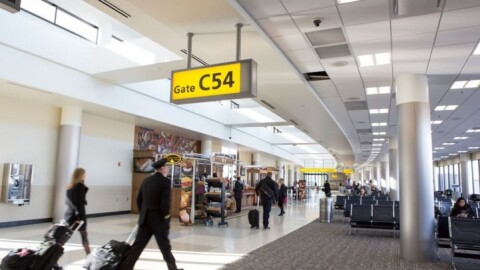Ohio State's Don Scott Field airport, which first opened in 1942, will undergo major renovation over the next 10 years. Modernizing the terminal, building a new flight education center and upgrading training aircraft will cost about $20 million.
WOSU's Debbie Holmes talked to David Williams, Dean of the OSU College of Engineering, who is in charge of the airport.
The below is an automated transcript. Please excuse minor typos and errors.
Debbie Holmes: So Don Scott Field opened in 1942. That's a very long time ago. Was there much that happened over the airport in the decades since then?
David Williams: Very little, in fact. It was started of course to train pilots for World War II and after the war it continued to train pilots. Our aviation department continued to look at areas beyond training pilots, like airport management, so there were degree programs associated with the airport. And many other colleges used the airport and the land out there for studies as well.
Debbie Holmes: So how extensively was it used for Ohio State students then, in training?
David Williams: Quite considerably. And we've had the flight training program since the 1940s, so a very long-established and very successful program, and we intend of course to continue to build that and grow that, particularly in light of the forthcoming shortage of pilots, which many of the airlines are concerned about.
Debbie Holmes: What are the goals of this renovation?
David Williams: The goal of the renovation are twofold. First of all, we will replace the original 1943 terminal with a modern terminal to accommodate the growing traffic that we're seeing at the airport. And we will build a brand new flight education center to train the pilots of the future, which will involve new flight simulation equipment and appropriate classrooms. And we're also in the process of upgrading the fleet of trainer aircraft in which our students learn to fly. The new hangars, the t-hangars, are actually under construction and they should open in June 2017. And they will housed around 50 planes that are currently at Don Scott Field but are parked in the open rather than under cover.
Debbie Holmes: Will the type of plane that can fly in and out of Don Scott, will that change?
David Williams: No, that will not change. We can accommodate an extraordinary range of planes at Don Scott Field, from small commercial jets all the way down to individuals' own planes and the student trainers, which again, are small single engine planes.
Debbie Holmes: I understand that one of the runways will be expanded. Can you tell me how that's going to happen and what that means, then, for air travel?
David Williams: The aim of the extension of the runway is not to accommodate bigger jets. As I said, very significant sized jet can land there if they need to. The aim of the runway extension is threefold. First of all, safety. If the runways that we currently have are compromised by rain or sleet or snow on the runway, then the larger business jets serving many of the companies in this area can't land at Don Scott Field safely, so they go to Port Columbus - sorry, John Glenn International. That's not good for the company, that plane is not where they wanted to be. So that is of concern.
The second issue is the noise. With a longer runway, in fact, you can approach, particularly if you're landing over Worthington for example, you can approach from a higher angle and so that means the flights over Worthington on the longer runway would indeed have higher flight paths. So the noise will be reduced during the landing process.
And the third reason, again, goes to our customers. Some of the bigger jets, again, with local companies like Worthington Industries and Advanced Drainage Systems and so on. Can't take off with a full load of fuel, because the runways are too short, which means if they're going on business to the west coast then they have to land somewhere in, say, Nevada or Utah to refuel. And that means we don't sell them the fuel, which is not good for our business, and it means it costs them more time, which is not good for their business.
Debbie Holmes: We know there was some talk about privatization in the last five to 10 years. Is that now completely off the table?
David Williams: No it is not. The business of the University and the engineering college, of course, is the education of students and research and creation of new knowledge and so on. And there is a role for an airport in all of those areas. The day-to-day business of landing planes and refueling them and flying them out again is not something that is an area particularly worthy of study and education and so on. So it is still on the table. At the appropriate time, we will look at bringing in a professional organization to run what's called the fixed base operations of the airport.




